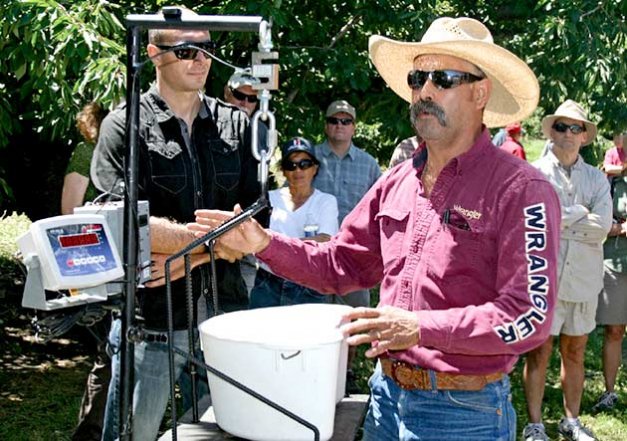
Carmelo Gamez of Orchard View Farms sees advantages to paying workers by the pound rather than by the bucket.
Geraldine Warner
Growers who have seen a new cherry harvest monitoring system developed at Washington State University are eager for it to be commercialized.
The system would enable growers to pay each worker based on the exact weight of the cherries picked, which could save growers money and eliminate arguments over the quantity of cherries in picking buckets.
Typically, growers pay pickers a fixed amount per bucket or lug picked, but not all the containers are filled to the same level. Growers employ checkers to try to ensure that workers only empty fully filled buckets into harvest bins.
The new system developed by Dr. Yiannis Ampatzidis, postdoctoral researcher at WSU, Prosser, incorporates a portable digital scale onto which a worker places a filled bucket so that a data logger can record the weight.
Each picker wears a radio frequency identification (RFID) wrist tag, which is scanned as the bucket is weighed so that the fruit is attributed to them. The computer then prints out a receipt for the worker to keep.
The cumulative weight of fruit deposited in the bin by each worker is tracked, and the data can be uploaded from a secure digital card into payroll software. The system also tracks the total weight of fruit in the bin.
After a bin is filled, the monitoring system can be moved to the next bin.
Cut costs
The system is being beta tested in commercial orchards. Mike Omeg of The Dalles, Oregon, a grower who is testing it, said there’s the potential to cut labor costs significantly by being able to pay pickers on a per-pound basis.
He figures that at his orchard, a 20-pound bucket actually contains, on average, just over 19 pounds of cherries when filled, despite close supervision of workers. He figures he could save up to $10,000 each season on his farm by paying by the pound rather than the bucket.
In addition, it would allow checkers to focus on the quality of the fruit being picked rather than on the need for pickers to fill the buckets to the top. “For me, a main savings is in eliminating debate in the orchard about how much they picked and what a full bucket is,” Omeg said. “We fight with that all the time.”
In fact, pickers needn’t fill their buckets. They might reach a point in the orchard where it makes sense to dump a partial bucket—before moving their ladder, for example.
Besides being advantageous to the grower, Omeg thinks the new system would be fairer to the pickers because they’d know they were paid for exactly how much they picked, and it would enable them to pick more efficiently. It would also help avoid conflicts that arise when a checker appears to favor certain pickers.
“It eliminates that drama and any debate about inequity in the orchard among picking teams,” he said. “I think this is the way to go.”
Ampatzidis is working on improving the battery power supply and making the equipment more rugged for outdoor use. Software is being developed so that the data can be transmitted to a server to allow harvest and picker efficiency to be monitored in real time.
Because the system incorporates a GPS (global positioning system) unit, the data could be used for yield mapping or in-field traceability. Ampatzidis noted that if the data are used for payroll purposes, the scale must be certified.
Dr. Matt Whiting, cherry horticulturist with WSU, said the university is looking into various roads to commercialization due to the strong interest in the system.
Omeg sees potential for growers to rent the equipment, rather than buy it, as not all growers in the Pacific Northwest are harvesting cherries at the same time. For example, growers in Washington’s Tri-Cities area have usually finished picking by the time harvest begins in The Dalles.
Carmello Gamez, horticultural manager at Orchard View Farms in The Dalles, liked the fact that pickers would be paid for what they picked. They can overfill their bucket and be rewarded for it, or they can dump a partial bucket and still get paid.

I’d like to know who I should contact about purchasing one of these systems.
Would like to purchase a system like this. Any info would be helpful, thanks!